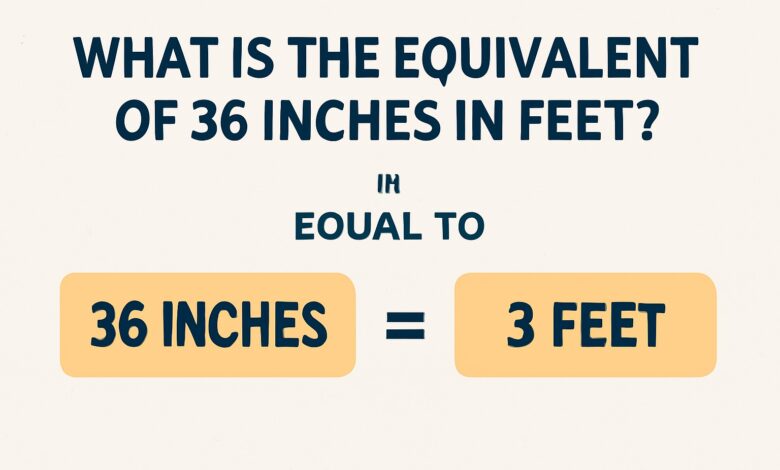What is the Equivalent of 36 Inches in Feet? Understanding Length Conversion
A Simple Guide to Converting 36 Inches to Feet and Understanding Length Measurements.

When dealing with measurements in various fields, understanding unit conversions is essential. One common conversion is between inches and feet, especially when working with measurements in everyday tasks or professional fields such as construction, design, and even fashion. In this article, we will explore how to convert inches to feet, the importance of accurate conversions, and practical applications for this knowledge.
Length Conversion Basics: What is the Equivalent of 36 Inches in Feet?
The equivalent of 36 inches in feet is 3 feet. The conversion process involves dividing the number of inches by 12, as there are 12 inches in a foot. This simple yet essential conversion is foundational in many industries and daily activities, such as determining furniture sizes, measuring room dimensions, or calculating distances in construction projects.
To understand why the number 12 is crucial, let’s briefly discuss measurement units. Inches and feet are part of the imperial system, used predominantly in the United States and other countries that have retained the imperial system for everyday use. In the metric system, however, measurements are more commonly in centimeters, meters, and kilometers.
Now, let’s delve deeper into length conversion, examining both basic and complex cases that might require additional mathematical methods.
Mathematical & Formula-Based: Converting 36 Inches to Feet
Conversion Formula: How to Convert Inches to Feet
The formula for converting inches to feet is straightforward:
-
Inches ÷ 12 = Feet In our case:
-
36 inches ÷ 12 = 3 feet
Division Method and Approximation
The division method is simple, but in some cases, when dealing with fractional inches, it’s important to ensure that the decimal places are rounded off accurately. For instance, if you were converting 37 inches to feet, the result would be 3.083 feet, which can be approximated to 3.08 feet when rounded to two decimal places. This approximation becomes crucial in precise measurements, especially in fields like architecture or interior design, where even small deviations can impact the overall design or structure.
Measurement Systems: Inches, Feet, and Their Alternatives
Imperial System vs. Metric System
In the imperial system, inches and feet are standard units of measurement for length, with 12 inches making up 1 foot. This system is most commonly used in the United States. However, many other countries use the metric system, where the basic unit of length is the meter. To convert between these systems, additional conversions are necessary:
-
Inches to centimeters (1 inch = 2.54 cm)
-
Feet to meters (1 foot = 0.3048 meters)
While the imperial system is widely used in certain countries, the metric system is more commonly adopted globally, making conversion skills essential when dealing with international measurements.
US Customary Units and SI Units
Both the US customary units and SI units are part of standardized measurement systems, though the US system retains feet and inches, while the SI system primarily uses meters and centimeters. Understanding these systems ensures that professionals across different countries can collaborate on projects and share accurate measurements.
Practical Applications of Inches and Feet Conversion
Construction Measurements and Carpentry
In the construction industry, accurate construction measurements are paramount. Whether you’re measuring materials for a building or designing a layout, knowing how to convert inches to feet is essential. For example, when working with wood in carpentry, you may need to convert inches into feet to calculate the length of a piece of lumber. For instance, if a carpenter has a board that measures 48 inches, it’s helpful to convert that into 4 feet to better understand how it fits into a layout or space.
Interior Design, Furniture Dimensions, and Blueprint Scaling
For interior design, furniture dimensions, and blueprint scaling, converting measurements like inches and feet can help create accurate designs. When specifying dimensions for a sofa or determining the space for a new appliance, the ability to convert between these units helps interior designers and architects work more efficiently.
In blueprint scaling, designers may need to adjust the size of objects or structures on paper by converting measurements into the right units. Understanding the conversion between inches and feet ensures that the design’s scale remains intact, and everything fits as intended.
Clothing Sizes and Fabric Measurement
In the fashion and clothing industries, clothing sizes are often based on measurements like height and waist circumference. In countries that use the imperial system, clothing sizes may be listed in feet and inches. Additionally, fabric measurement for clothing or interior design projects often involves converting inches to feet, especially when working with large rolls of fabric or large spaces that need to be measured accurately.
Also Read Here: How Much Does a Gallon of Gas Weigh?
Online Tools & Resources for Conversion
Conversion Calculators and Measurement Apps
Today, there are many online conversion calculators and measurement apps available for quick and easy conversions. These tools help save time and reduce errors in tasks that require frequent unit conversions. By simply entering a number of inches, you can quickly find its equivalent in feet, meters, centimeters, or any other unit.
For example, a quick search on a conversion calculator for 36 inches yields the result of 3 feet, making it incredibly easy for professionals in various industries to get their measurements accurately without manual calculations.
Interactive Tools and Conversion Software
In addition to online tools, interactive tools and conversion software are available for more specialized applications. For example, architects, designers, and engineers often use unit conversion tables and interactive measurement software to input dimensions and scale up their designs.
Also Read Here: How Many Grams Are in 2.5 Kilograms?
FAQs About Length Conversion
1. Why is it important to convert inches to feet?
Converting inches to feet is essential when working with larger measurements, especially in fields like construction, interior design, and carpentry. It helps ensure accuracy and clarity when measuring large spaces or materials.
2. How do you convert inches to feet manually?
To convert inches to feet manually, divide the number of inches by 12. For example, 36 inches ÷ 12 = 3 feet.
3. What is the formula for converting feet to inches?
The formula for converting feet to inches is simple: multiply the number of feet by 12. For example, 5 feet × 12 = 60 inches.
4. Can online tools be used for accurate conversion?
Yes, online conversion calculators and measurement apps are accurate and save time by providing instant results.
5. What is the metric equivalent of 36 inches in centimeters?
To convert inches to centimeters, multiply the number of inches by 2.54. For 36 inches, 36 × 2.54 = 91.44 cm.
Conclusion
Understanding length conversion is an essential skill for various industries and everyday tasks. Whether you’re measuring materials for construction, designing a space, or calculating fabric lengths, knowing how to convert between inches and feet is crucial. With the help of simple formulas and online tools, anyone can master these conversions quickly and accurately. Additionally, understanding the difference between the imperial and metric systems will ensure smooth communication and collaboration in global projects.
The next time you encounter a measurement task involving inches and feet, you’ll be able to confidently convert the units and complete the job with precision.




